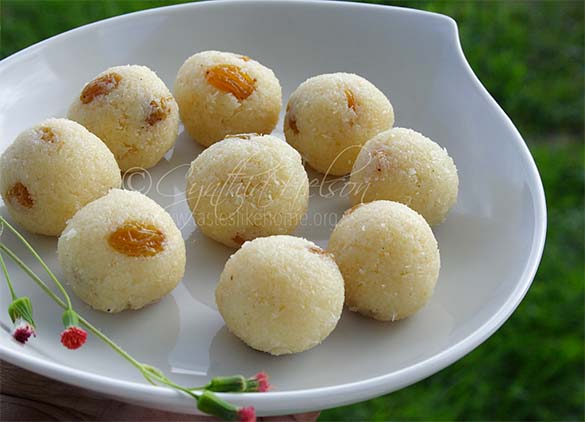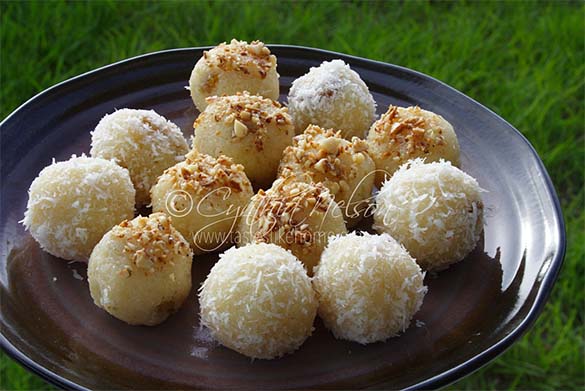 Bring on the sugar rush, it’s Diwali!
Bring on the sugar rush, it’s Diwali!
The religious significance of the occasion and what it represents is not lost on us, it is the festival of lights, the triumph of good over evil, lightness over darkness, a time of peace and goodwill. It is a season of hope. It is a time of celebration, and the giving of gifts; it is also a time for feasting on some of our favourite sweet treats that are synonymous with the festival.
What’s your favourite sweetmeat to have at Diwali? Is it Kheer (sweet rice), Parsad, Gulab Jamun, Korma, Peera, Burfi, Roat, or Laddoo? Because I can have Parsad, Roat and Kheer anytime by making it, I like to save the eating of Laddoo for Diwali, specifically, Coconut Laddoo.

(Photo by Cynthia Nelson)
Laddoo/Laddu is one of those sweets that is especially associated with celebrations – birth, weddings, religious festivals, and other special occasions. It also forms part of the prasad offerings at temples. Laddoo can be made with a variety of ingredients but the most popular are those made with chickpea flour, wheat semolina and coconut. You can even make Laddoo with sago – toast the sago and then grind it into a powder. Of course these days it is easy to get ground sago.
Traditional foods and dishes are steeped in heritage cooking and often the process is long; it is about technique and perfection. A lot of Indian sweetmeats start with the long, slow cooking of milk, and milk and sugar combined. However, there are many ways a home cook can achieve excellent results by using certain already prepared ingredients, in this case, sweetened condensed milk.
With all the cooking that is likely to be taking place for the religious festival, using this shortcut – making the Laddoo with condensed milk – will not only cut down on cooking time, but it will turn out beautifully.
COCONUT LADDOO
Yield: 20 – 22
I used fresh coconut (removing the brown skin to give it a uniform look but you can leave it on). However, you can use unsweetened desiccated coconut.
INGREDIENTS
· 2 teaspoons ghee or vegetable oil
· 1 dozen raw almonds, finely chopped (optional)
· 4 cups fresh grated coconut
· 1 x 14 oz. can condensed milk
· ¼ teaspoon ground cardamom (elaichi)
· ¼ cup golden raisins (optional)
DIRECTIONS
1. Heat 1 teaspoon of ghee/oil in small frying pan and toast the nuts until fragrant and golden. Set aside to cool in a bowl or small plate.
2. Add the coconut to a dry heavy bottomed pan or pot (a karahi will work too). Place on low heat and dry toast the coconut; do not let it develop a colour, you just want it a little dry. Stir it around often to ensure that it does not stick to the bottom of the pan/pot. This process should take 6 – 8 minutes.
3. Remove about ¼ cup of the coconut and spread it in an even layer on a small plate and set aside to cool.
4. Pour the condensed milk into the remaining coconut in the pot/pan and stir well to mix (still on low heat). Let the coconut and milk mixture cook until it thickens, gets pasty and comes away easily from the sides of the pan. The mixture will stiffen. Throughout the process of cooking, stir the mixture frequently to ensure that it does not scorch at the bottom. The time for this step will vary depending on the heat and type of pot/pan. Also, if you are using fresh coconut, the cooking time will be longer than if using desiccated coconut due to the moisture in the fresh coconut.
5. Sprinkle in the cardamom and raisins about 2 to 3 minutes before you think the mixture will be done cooking and mix well.
6. Remove the mixture from the heat and let cool until you can handle it, however, do not let the mixture come to room temperature before you roll the laddoo. It must be rolled while the mixture is still very warm.
7. Rub a little of the remaining ghee/oil in the palm of your hands and take the mixture a bit at a time and roll into balls, make them as large or small as you like.
8. Here are your options for garnishing – roll some of the laddoo in the reserved coconut or take the laddoo, one at a time and press into the chopped almonds (only at the top). Some, you can leave without garnishing.
9. Let laddoo cool completely then serve, or store in an airtight container in the refrigerator. When ready to serve, bring the laddoo to room temperature to enjoy the full flavour and texture of the laddoo.
NOTES
· When rolling the laddoo, it should not be sticking to your hands. It can feel tacky, but the mixture should not be coming off on your hands, if it is, then it needs to be cooked further until it is drier. Add it back to the pan and continue to cook on low heat. On the other hand, if the laddoo is cracking as you roll, it means that it is too dry. Add it back to the pot/pan along with a little whole milk and cook to the right consistency.
· Instead of using the almonds as a garnish, they can be added directly into the mixture at the same time with the raisins and cardamom.
· Raisins and almonds can be omitted from the laddoo mixture.
· Use whatever nuts and dried fruits you have.
· Use the laddoo rolled in the fresh coconut garnish first as they will have a shorter shelf life. The others can keep in the refrigerator for up to 2 weeks. If you used desiccated coconut, it would keep longer in the refrigerator and can also be kept at room temperature in an airtight container in a cool place for 2 weeks.
Happy Diwali!
Cynthia










